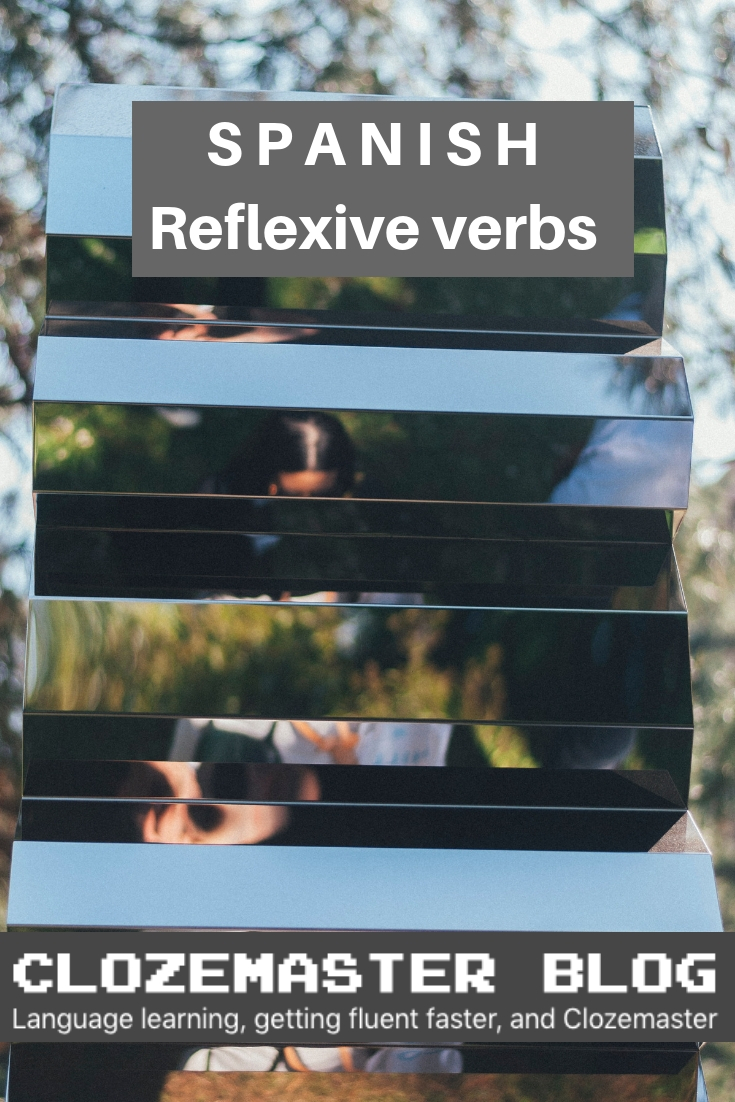One of the biggest confusions for Spanish learners is the reflexive. It is a feature of Spanish that’s really different to English, so it is really hard to understand just by translating directly between the languages. So, let’s break down Spanish reflexive verbs and see how they’re used.
First thing’s first – what are Spanish reflexive verbs?
A reflexive verb is a verb which has a self-referential pronoun, either next to it or attached to it. A self-referential pronoun means that the subject of the verb and the pronoun are the same. Essentially, in some cases, you can think of it like the English “self”. Of course, that’s not always the case, which is why it does lead to some confusion, but we’ll see why.
How are Spanish reflexive verbs formed?
Reflexive verbs are formed with two main parts. The main verb is who is performing the action, and the reflexive pronoun is who the action is directed at. In the case of reflexive verbs, these will both refer to the same person.
The good news is that there are no new conjugations or verb-endings for reflexive verbs. The only thing you have to remember is the pronoun which goes with each of the person forms. Once you know these, you can use them in any tense or verb formation – the reflexive pronouns don’t change. Also, they are the same whether it’s an -ir, -er, or -ar verb. So, let’s have a quick look at how they’re formed with an example:
General verb: levantar | to pick up
Reflexive verb: levantarse | to get (oneself) up
1st person: (yo) me levanto
2nd person: (tú) te levantas
3rd person: (él/élla) se levanta
1st person plural: (nosotros) nos levantamos
2nd person plural: (vosotros) os levantáis
3rd person plural: (ellos/ellas/ustedes) se levantan
As you can see “levantar” is a regular -ar verb. The only difference between this and a regular conjugation is the reflexive pronoun that comes before the verb.
Uses of Spanish reflexive verbs
Verbs that are always reflexive
There are some verbs which you will almost never see without their attached reflexive pronoun, so they should always be used with the pronoun attached. In this case, it generally has very little to do with the sense of “self”, and is simply something that needs to be remembered or picked up the more you use the language. Here are some examples, but it’s definitely not an exhaustive list, so keep an eye out for these as you get to see and hear more Spanish sentences.
- Reírse – to laugh
- Acordarse – to remember
- Imaginarse – to imagine
- Preocuparse – to worry
- Enterarse – to find out
- Casarse – to marry
- Atreverse – to dare
- Quedarse – to stay
- Burlarse – to make fun of/to tease
- Caerse – to fall
- Divertirse – to have fun
- Portarse – to behave
- Morirse – to die
Verbs that are sometimes reflexive
There are many verbs which have a different meaning when they are reflexive than they do without the reflexive pronouns. See the example with “levantar” above. The verbs which take on the reflexive pronoun are usually inherently self-directed. Even if there is no sense of “self” in the English translations, when you think about it there is a meaning of doing something to yourself in all the reflexive versions.
Take a look at these examples:
Dormir – to sleep | Dormirse – to fall asleep
Ex: Ella duerme ocho horas cada noche. | She sleeps 8 hours a night.
Ex: El niño se durmió a las nueve. | The boy fell asleep at 9.
Despertar – to wake (someone) up | Despertarse – to wake up
Ex: Mi madre me despierta con el desayuno. | My mother wakes me up with breakfast.
Ex: Me desperté para hacer el desayuno. | I woke up to make breakfast.
Lavar – to wash | Lavarse – to wash (oneself)
Ex: Mi hermano lavó su auto. | My brother washed his car.
Ex: Me lavo el pelo una vez a la semana. | I wash my hair once a week.
Molestar – to annoy | Molestarse – to be bothered
Ex: Me molesta que no pare de hablar. | It annoys me how Sofia doesn’t stop talking.
Ex: No te molestes a pararte. | Don’t bother to stand up. (Note how there are two reflexives working in this sentence)
Recordar – to remember | Recordarse – to remind oneself
Ex: Siempre que la veo recuerdo aquella noche. | Every time I see her I remember that night.
Ex: Me recordé que mi esposa es la mujer que más amo en este mundo. | I reminded byself that my wife is the woman I love most in this world.
Verbs that are only reflexive when they mean “self”
For verbs that have strong meanings on their own, adding the reflexive pronoun just adds the sense that the action is being done to oneself instead of to someone else. Here are some common examples.
Hablarse – to talk to oneself
Mirarse – to look at oneself
Ex: Me miro en el espejo y no me gusta lo que veo. | I look at myself in the mirror and I don’t like what I see.
Dudarse – to doubt oneself
Entenderse – to understand oneself
Encontrarse – to find oneself
Hacerse – to make oneself (something)
Ex: Me hago una paella para el almuerzo. | I make myself a paella for lunch.
Amarse – to love oneself
Ex: Ese tipo es muy creído, parece que en verdad se ama. | That guy is so stuck up, it seems like he loves himself.
Get the Spanish Reflexive Verbs Worksheet PDF – over 200 fill-in-the-blank cloze sentences to practice conjugating Ir in context (or sign up for Clozemaster to play thousands of Spanish fill-in-the-blank cloze sentences 🙃).
Verbs when they are followed by direct objects
One of the more seemingly strange uses of the reflexive is where it’s used in a normal verb followed by an object. Here, it could carry the reflexive pronoun or not without changing the meaning of the sentence. The only reason it’s used is for emphasis on the subject being the person carrying out the action for themselves.
Some examples:
Comerse (una manzana)
Ex: Mi abuela se comió una manzana antes de irse. | My grandmother ate an apple before leaving.
Verse (una película)
Ex: Cuando mi novio terminó conmigo, pasé tres días viéndome películas y comiendo helado. | When my boyfriend broke up with me, I spent three days watching movies and eating ice-cream.
Beberse (una cerveza)
Ex: Miguel sale de trabajar y se bebe una cerveza. | Miguel gets off work and drinks a beer.
Tenerse (un buen día)
Ex: Ténte un buen día en la escuela! | Have a good day at school!
Generic “you”/ passive sentences
When you want to explain that an action has been carried out but you don’t want to mention the subject, a good strategy is to use the reflexive structure. This also works when you want to make a general statement without speaking to anyone in particular. This is similar to how we would use “one” or “you” in a generic sense in English.
Let’s see how it plays out with some examples.
Se puede
Ex: No se puede comprar nuestra tierra. | You can’t buy our land. / Our land can’t be bought.
Se vive
Ex: Sólo se vive una vez. | You only live once.
Se sabe
Ex: Se sabe que Pablo Picasso era un artista extraordinário. | It is known that Pablo Picasso was an extraordinary artist.
Se conoce
Ex: Este pueblo se conoce como Puerto Dorado. | This town is known as Puerto Durado.
Not to be confused with Spanish reflexive verbs: Reciprocal verbs
There is one thing you need to be careful of when looking for reflexive verbs. Reciprocal verbs look the same in form as Spanish reflexive verbs in the plural, but their meaning is different. Reciprocal has the meaning of “each other” Usually the context will tell you which one to employ, but sometimes it is ambiguous, so it could be either “each other” or “themselves/ourselves”.
E.g:
- “Nos vemos” could mean either “we see each other” or “we see ourselves”. But if you say “nos vemos mañana a las doce,” you obviously mean “we’ll see each other.”
- “Nos queremos” could mean either “we love each other” or “we love ourselves”. But if you say, “nos queremos así como díos nos crió,” it’s easy to interpret that as “ourselves”.
If you want to make it less ambiguous, if you mean each other, you can add “el uno al otro” or “entre ellos”. If you mean themselves/ourselves, you can add “a nosotros mismos/as” or “a ellos mismos/as” to the end of the sentence.
E.g:
Se ayudan el uno al otro. | They help each other.
Se juegan entre ellos. | They play with each other.
Se tratan mal a ellos mismos. | They treat themselves badly.
Word order of Spanish reflexive pronouns
Another thing that also sparks frustration in Spanish reflexive verb learners is the word order. In reality, it should actually be easier because the word order is pretty flexible. Let’s look at how it works.
Firstly, for conjugated verbs, the order will always be the same as what you can see in the conjugation table at the top of this page – i.e: this order is always fixed.
If the verb is not conjugated, and instead is in its infinitive form, there are two positions for the reflexive pronoun to go. The first is before the conjugated verb in the sentence, and the second is attached to the end of the infinitive reflexive verb. This does not change the meaning of the verb at all, and it is entirely up to you which position you put it in.
No me quería levantar __.
No __ quería levantarme. | I didn’t want to get up.
María nunca __ quiere atreverse a hacer nada para no fallar.
María nunca se quiere atrever __ a hacer nada para no fallar. | María is never going to dare to do anything in order not to fail.
Remember, you can only put the pronoun in one of the two available positions, never both. See if you can find some reflexive sentences and play around with them, moving the pronoun to the other correct position.
Well, this brings us to the end of our lesson on Spanish reflexive verbs. I hope that has cleared up what they do, and why we see “se” so much in Spanish sentences. Now go forth and talk about yourself!
Learn Spanish in context with ClozemasterClozemaster has been designed to help you learn the language in context by filling in the gaps in authentic sentences. With features such as Grammar Challenges, Cloze-Listening, and Cloze-Reading, the app will let you emphasize all the competencies necessary to become fluent in Spanish. Take your Spanish to the next level. Click here to start practicing with real Spanish sentences! |



